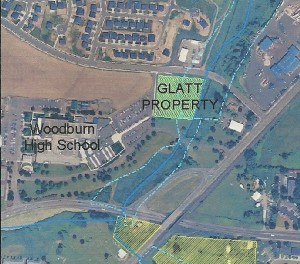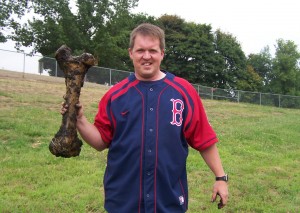Woodburn High School
The Ice Age in Woodburn, Oregon
 Woodburn, Oregon is a rural city of 20,000 people located in the heart of the Willamette Valley. Through the middle of the city, runs a slow moving body of water called Mill Creek. Today this creek contains freshwater clams, snails, and various larvae, also fish like the three-spined stickleback and sculpins, as well as the occasional nutria. Its banks are dominated by reed canary grass, and blackberry bushes. It is a typical non-assuming creek like many in the Valley. However, since 1996 scientists, volunteers, and high school students have been looking at an ancient ecosystem beneath the surface.
Woodburn, Oregon is a rural city of 20,000 people located in the heart of the Willamette Valley. Through the middle of the city, runs a slow moving body of water called Mill Creek. Today this creek contains freshwater clams, snails, and various larvae, also fish like the three-spined stickleback and sculpins, as well as the occasional nutria. Its banks are dominated by reed canary grass, and blackberry bushes. It is a typical non-assuming creek like many in the Valley. However, since 1996 scientists, volunteers, and high school students have been looking at an ancient ecosystem beneath the surface.
To reach the soils of this ancient ecosystem heavy equipment is used to dig trenches up to 20 feet deep. Because of this depth and the instability of the trench walls, the soil containing fossils has to be bought to the surface. Over the years many animal bones have been found, including small rodents like muskrat, voles, and shrew; larger mammals like beaver, deer, and elk; birds like cranes and cinnamon teal; and turtle shell fragments. The deposits also preserve plant remains, including seeds of bog bean and Oregon grape; wood and leaves from willows; and cones from spruce trees. Together, these fossils provide an opportunity to look back at an environment that existed over 10,000 years ago.
The largest and most exciting find was made in September of 2008. While Woodburn High School students were underway with their annual dig, an almost completely articulated skeleton of a large mammal was discovered. Students and teachers sifted through the soil finding all sizes of bones, some complete, others in fragments. As word spread about the find, paleontologists came to see the bones and made some important observations also students conducted research of their own on the bones. Important conclusions were made: first, the bones were identified as an extinct ice age bison called Bison antiquus. Second, it was clear there were no scavenger marks on any of the bones, indicating that after the animal died it was not eaten. A third observation was that the bison was a very large male with growth plates in the long bones and vertebrae that had not completely fused, indicating that he was not fully mature. Furthermore, there was a large, abnormal bone growth on the back right ankle that turned out to be a form of cancer called osteomyletis. Overall, this was an exciting find and would be an excellent opportunity for high school students to engage in authentic scientific research
Other digs since then have found more bison bones, like a complete bison skull in August 2010 and a right humerus in September 2010. Ribs and various vertebrae have also been found. Most of these do not belong to the 2008 individual, suggesting that Woodburn may have been a migratory pathway for bison at the end of the ice age.
This web page is dedicated to the observations and research on the bison as well as the smaller animal bones and plant remains discovered in Woodburn. The information gathered is important to the scientific community, but the opportunity young scientists in Woodburn have in learning science from a perspective that few get to experience is just as important, and will continue to engage and inspire students for years to come.
To learn more about this animal and the digs going on at the high school contact David Ellingson at dellingson@woodburnsd.org